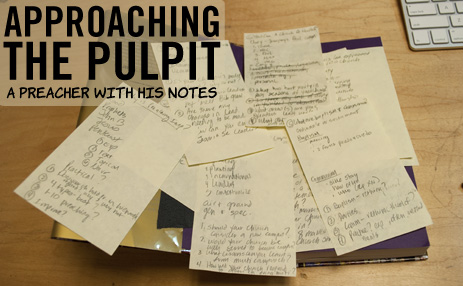Latest
-
Objections to the Christian Faith from the Unchurched and De-Churched
 Tue Dec 02, 2014
Tue Dec 02, 2014
by Resurgence -
Craig Groeschel: We Innovate for Jesus
 Tue Oct 14, 2014
Tue Oct 14, 2014
by Resurgence -
Mark Driscoll: Revelation
 Tue Oct 07, 2014
Tue Oct 07, 2014
by Resurgence -
RESURGENCE LEADERSHIP #034: JOHN PIPER, WHY I TRUST THE SCRIPTURES, PART 2
 Tue Sep 30, 2014
Tue Sep 30, 2014
by Resurgence -
Resurgence Leadership #033: John Piper, Why I Trust the Scriptures, Part 1
 Tue Sep 23, 2014
Tue Sep 23, 2014
by Resurgence

Archives
Approaching the Pulpit: A Preacher With His Notes
Preacher series: Click | View Series 
Sermon Manuscripts
Preachers aren't actors. We don't have to memorize our "script," although many effective preachers take a 12-page manuscript into the pulpit. Likewise, pastors aren't stand-up comedians. We aren't required to "take the stage" armed only with few thoughts scribbled on a piece of paper, though many good pulpiteers use only a simple outline. There are merits and drawbacks to both of these radically different approaches. A full manuscript allows you to craft more pregnant phrases that tend to stick in the mind of the hearer. The manuscript approach protects you from tangents that might lead you away from the main points of the text. The downside to a manuscript is that you are tempted to interact more with your notes than with God and people. It’s harder to follow the prompting of the Spirit when you are locked into a specific direction.
Using Outlines
The benefits of an outline are that you keep the big picture in front of you and tend to consistently move in that direction. Using fewer notes means that eye contact and interaction with people will happen more frequently. Many folks who use outlines say they go into the pulpit with a sense of freedom and confidence that they might not get with a manuscript. The downside of an outline is that it is easy to miss important details of the text. Outline preachers tend to preach longer because they are tempted to chase thoughts that occur to them in the preaching moment. Also, off-the-cuff humor and illustrations are usually underdeveloped and might not convey your intended meaning.
Something In-between
I use something between an outline and a manuscript. I write out certain parts of the sermon verbatim. The parts are phrases that I think will help expose the text, phrases that will stick with people. I often close the sermon by leaving people with questions to chew on. When I do this, I write them out very carefully and usually project them on a screen to focus the congregation on the questions. But I also step into the pulpit with bullet points that highlight the big ideas I want to communicate. This allows me to keep the sermon moving forward in a logical flow, and more importantly, leaves room for me to hear from the Lord in the "preaching moment." I can camp out on a particular verse or skip a particular illustration as the Spirit leads. There is not a prescribed biblical manner for preparing and delivering your sermon, which means you have freedom to explore your particular style as you prepare a sermon and proclaim the gospel. You may enjoy taking a look at this blog series by Josh Harris, where he posts the preaching notes of several well-known pastors, showing you what they take with them into the pulpit.